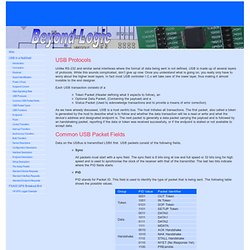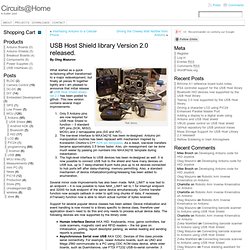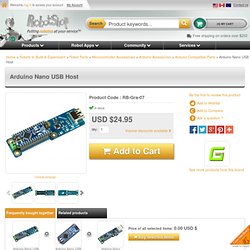

I2C come sistema di comunicazione tra schede Arduino UNO. Come collegare due Arduino usando il bus I2C.

Una caratteristica che reputo molto interessante è la possibilità di espandere Arduino tramite l’uso di shield. La maggior parte di queste schede aggiuntive sono però progettate per compiere una funzione specifica, non programmabile. Esistono alcuni metodi che permettono di comunicare con altri dispositivi utilizzando come canale di trasmissione dati i protocolli seriali (I2C, SPI o RS232).
Questo rende possibile demandare ad una scheda slave funzioni di elaborazione gravose, che non vogliamo far eseguire alla scheda master. Ho realizzato questo piccolo tutorial usando il bus I2C per creare uno scambio dati tra un Arduino ed un chip ATmega328 standalone. Il bus I2C, basandosi su due fili, non permette la comunicazione contemporanea tra Master e Slave. Using USB Host Shield with ArduinoHardware Fun.
There is a huge variety of shields that are available which can be stacked on top of an Arduino. Often there are more than one manufacturer for a single type of shield itself. In a way this is good, because as a user you are going to have multiple options. But it becomes a problem when the shield is pretty complex (like the USB Host Shield) and you have to use a library and the shields are not compatible with each other. One such shield which has many incompatible versions is USB Host Shield and in this post I am going to tell you how you can select the proper shield and also the changes that you have to do to make even the incompatible shields work with the library.
SparkFun USB Host Shield · watterott/KnowledgeBase Wiki. USB in a NutShell - Chapter 3 - USB Protocols. Unlike RS-232 and similar serial interfaces where the format of data being sent is not defined, USB is made up of several layers of protocols.

While this sounds complicated, don’t give up now. Once you understand what is going on, you really only have to worry about the higher level layers. In fact most USB controller I.C.s will take care of the lower layer, thus making it almost invisible to the end designer. Each USB transaction consists of a Token Packet (Header defining what it expects to follow), anOptional Data Packet, (Containing the payload) and aStatus Packet (Used to acknowledge transactions and to provide a means of error correction)
Area SX s.r.l. USB Host Shield library Version 2.0 released. Hub demo What started as a quick re-factoring effort transformed to a major redevelopment, but finally all pieces fit together tightly and I am pleased to announce that initial release of USB Host Shield library ver.2.0 has been posted to github.

This new version contains several major improvements:Only 5 Arduino pins are now required for USB Host Shield to function – 3 standard SPI pins (SCK, MISO, MOSI) and 2 remappable pins (SS and INT). The low-level interface to MAX3421E has been re-designed. Arduino pin manipulation routines has been replaced with mechanism inspired by Konstantin Chizhov’s C++ AVR pin templates. Developing Arduino code for HID Joystick. This article focuses on how to use the existing USB code library and HID report descriptor info to implement joystick functionality. Human readable HID report descriptor and report information can be easily obtained using USBHID_desc.pde sketch – see previous article for details. This information will help you getting field details such as size and count info. Also, if you don’t have Arduino Mega or 2560 to run USBHID_desc, report descriptor for your device can be obtained using one of many PC tools known as USB analyzers, or even the official usb.org device verification tool.
This article is written by Alex Glushchenko – a developer behind second revision of USB Host Library as well as majority of device support code. As you may already know report is a data structure used by HID device to return the information about the certain device parameters such as joystick coordinates or button events, or receive new settings such as switching on/off LEDs on keyboard. Arduino Shields. This is revision 2.0 of USB Host Shield.

Thanks to new interface layout it is now compatible with more Arduinos – not only UNO and Duemilanove, but also big Mega and Mega 2560 work with Standard variant of this shield out of the box. No more SPI re-wiring and code modifications – just solder included stackable connectors (2×3 ICSP connector’s female side should be facing down), plug and play! This shield is shipped as a kit, containing populated and tested board plus a set of stackable headers, which you need to solder on the board. USB Host Shield 2.0 for Arduino by Circuits@Home [CAH-ASSY-UHS-20S] - 23,90 € : lipoly.de, Alles für den Elektromodellflug. Arduino USB Host Shield [SHD038] - $24.00 : iStore, Make Innovation Easier. We recommend you to place the order in our new online store:
![Arduino USB Host Shield [SHD038] - $24.00 : iStore, Make Innovation Easier](http://cdn.pearltrees.com/s/pic/th/arduino-shield-innovation-46318444)
Felis/USB_Host_Shield_2.0. Arduino Nano USB Host. • Full and low-speed USB interface• Embedded host controller• Works with Android accessory mode• Breadboard friendly, small size 3.7'' x 1.0'' • Arduino Nano is not included.
